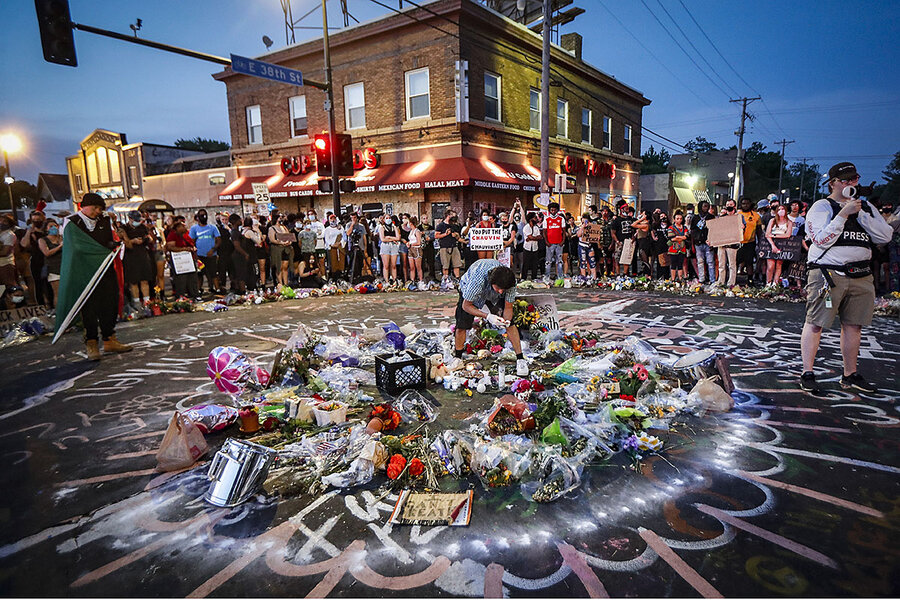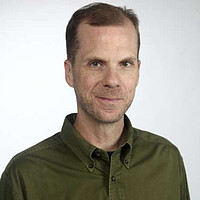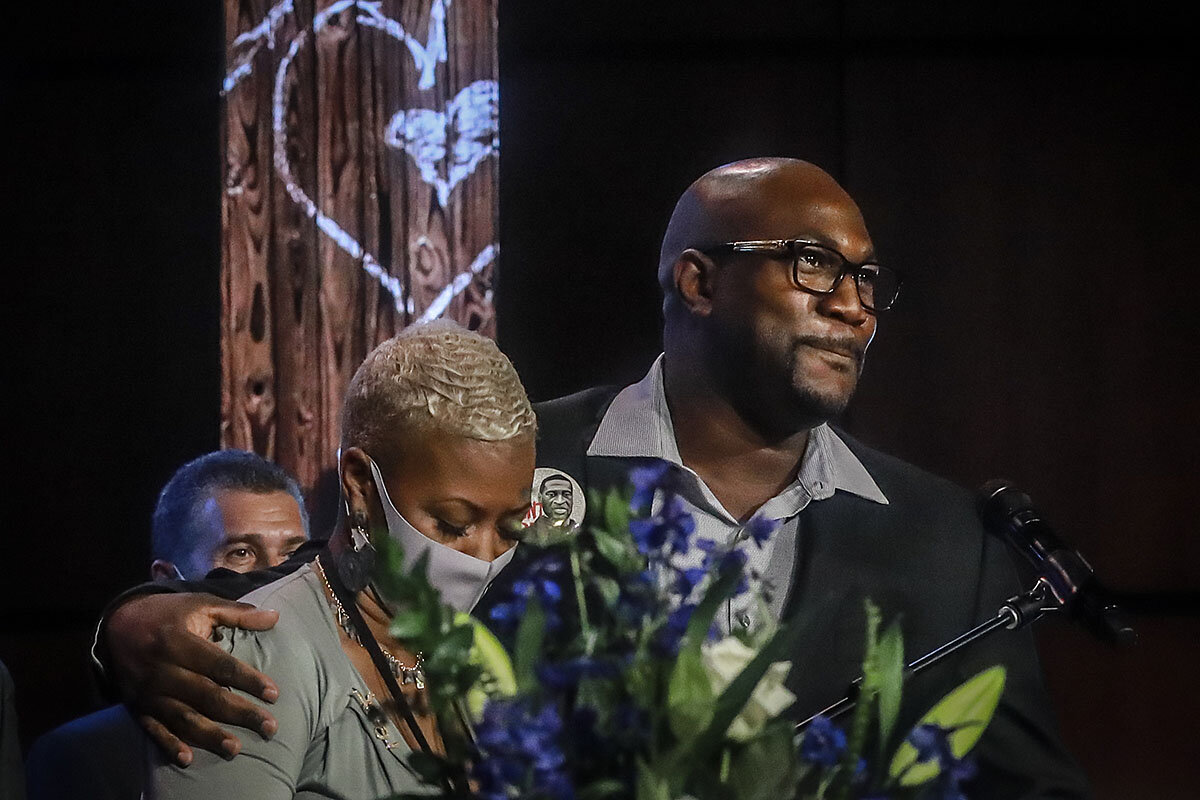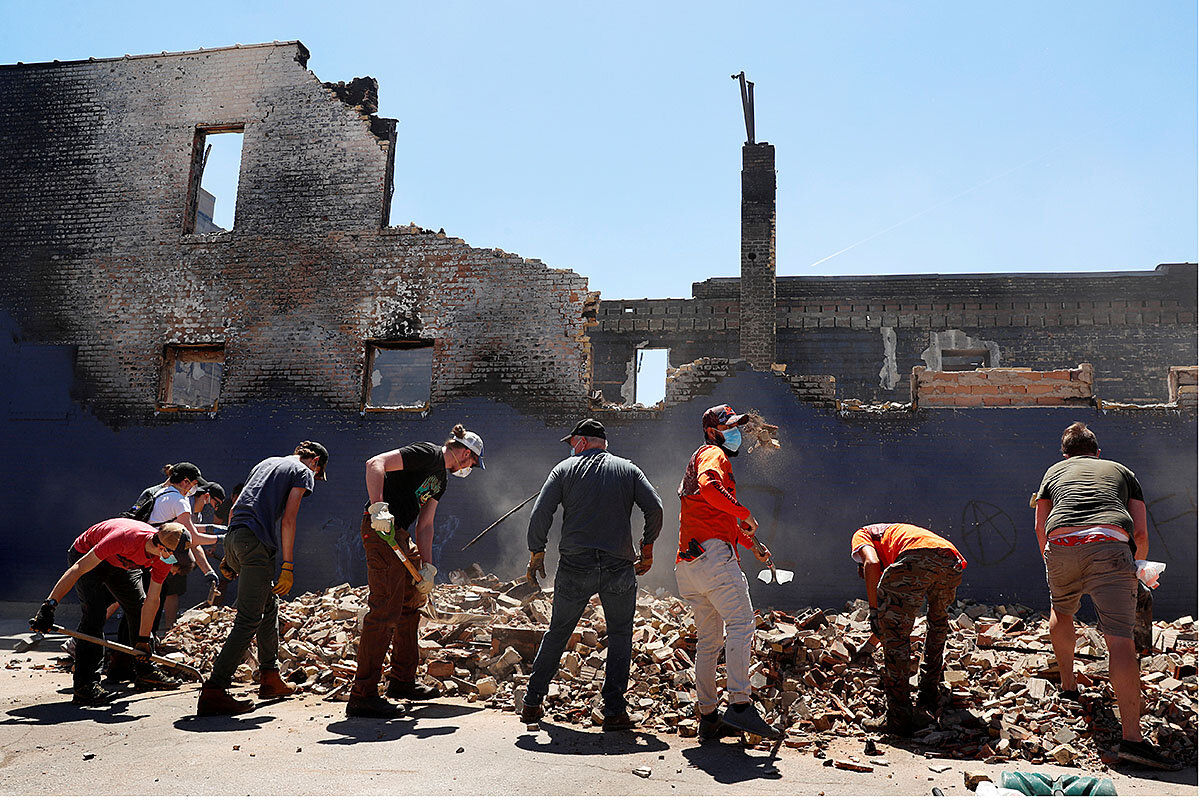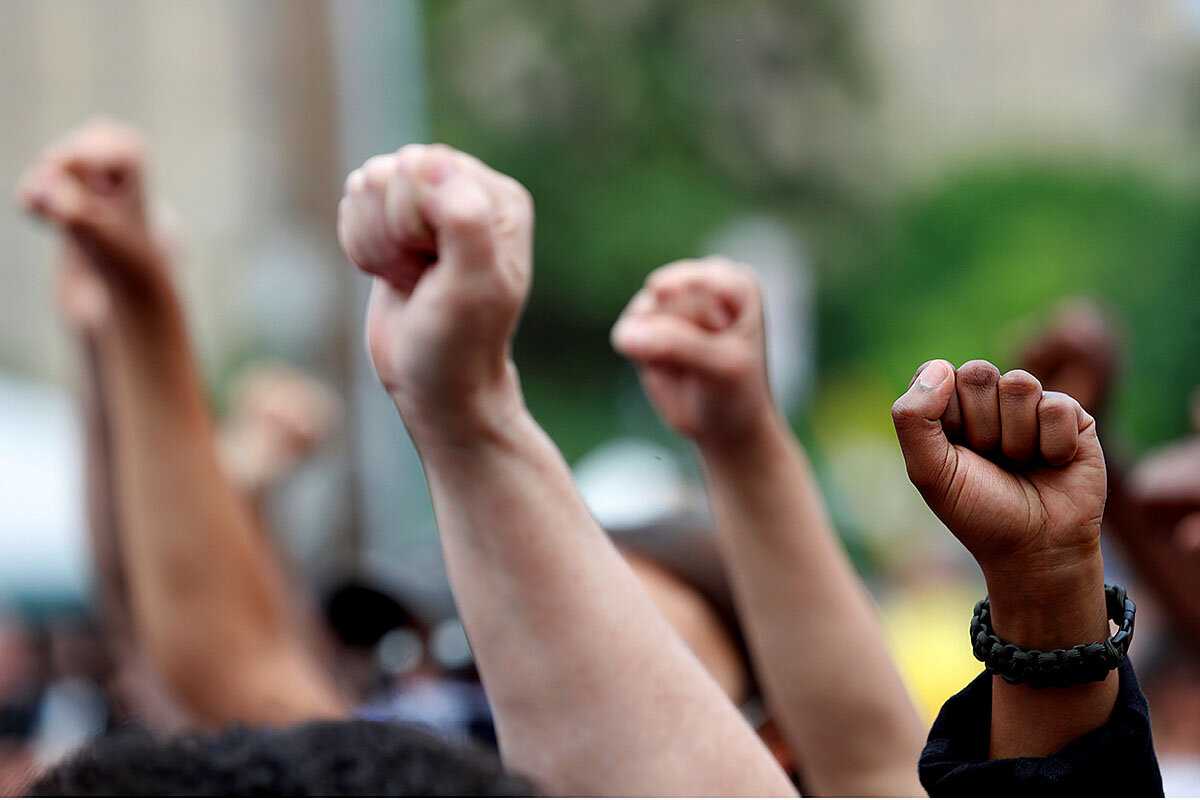Will Minneapolis become the Selma of the North?
| Minneapolis
The private memorial service for George Floyd had ended and Martin Rogers stepped out into the hazy afternoon light. He walked across the street and sat down on an empty park bench, and from that vantage point, he looked back and ahead, to the struggle then and now for racial justice in America.
He recalled a recent trip to Selma, Alabama, with his wife, who grew up there. They visited the Edmund Pettus Bridge, where in 1965 state troopers and sheriff’s deputies armed with tear gas and billy clubs attacked peaceful demonstrators marching in support of voting rights for African Americans. “Bloody Sunday,” as the confrontation became known, marked a seminal moment in the civil rights movement and prodded Congress to pass the Voting Rights Act that year.
“Walking onto that bridge – that was powerful,” says Mr. Rogers, a former grade-school teacher. “You could feel the history of what those marchers achieved.”
Why We Wrote This
Law enforcement violence against peaceful demonstrators in Selma, Alabama, in 1965 shocked the U.S. and sparked social change. Is George Floyd’s death at the hands of a police officer in Minneapolis a similar inflection point?
A Connecticut native who moved to Minneapolis in the early 1980s, he attended the memorial here for Mr. Floyd last week on behalf of the Christian church where he serves as an elder. He heard the Rev. Al Sharpton deliver a stirring eulogy for Mr. Floyd, the Black security guard who died on Memorial Day under the knee of a white police officer as other officers held him down.
“What happened to Floyd happens every day in this country – in education, in health services, and in every area of American life,” Mr. Sharpton told mourners, his voice rising. “It’s time for us to stand up in George’s name and say, ‘Get your knee off our necks!’”
The viral video of Mr. Floyd’s death ignited outrage and massive protests in Minneapolis that spread across the country, creating a groundswell that could represent the start of the nation’s largest grassroots movement since civil rights and the Vietnam War. The prospect inspires cautious hope among residents that their city might emerge from an uprising born of tragedy as the Selma of the North.
“What we’re seeing is a step forward,” Mr. Rogers says. “Change takes time, and I’m not sure everybody is ready to change. Black people – we’re ready. What we need is for everyone to stay involved and stay passionate.”
A different kind of movement
Civil rights luminaries, religious leaders, and politicians joined Mr. Floyd’s family for the memorial to commemorate his life and call for racial equality. Outside the sanctuary, a sound system carried the words of Mr. Sharpton and other speakers to hundreds of people gathered on the streets and in a nearby park. The demonstrators bore messages of solidarity – “Rest in Power George,” “Black Lives Matter,” “I Can’t Breathe” – on T-shirts, face masks, and cardboard signs.
The deep tensions between people of color and the city’s predominantly white police force exploded after a bystander’s video surfaced of Officer Derek Chauvin kneeling on Mr. Floyd’s neck for almost nine minutes. Shonda Henderson, who has raised her six children in Minneapolis, warns her two teenage sons to avoid cops whenever possible, a concern rooted in the department’s reputation for abusive behavior.
“I want to see the police violence against us stop and law enforcement start working for us,” says Ms. Henderson, a housekeeper at a downtown hotel. The demographics of the protesters – as much as the number and size of recent rallies – give her reason to think the emotion of the moment could evolve into a sustained movement.
“What’s different this time is I’m seeing everybody out here – Caucasians, Asians, Latinos. It’s not just African Americans,” she says. “We’re all sticking up for each other and realizing that these issues of equality affect every one of us.”
Millennials and Generation Z have supplied much of the energy and momentum behind the demand for racial justice in Minneapolis and elsewhere. Mariana Noyola, who will enter ninth grade this fall, convinced her parents to attend the gathering outside the memorial service.
“It’s scary to be African American in America. We’re looked at differently, we’re seen as dangerous, we feel more threatened,” she says. “Other people feel like our Blackness is some kind of weapon.”
The teenager sounded weary beyond her years as she recited the names of Black men killed by police in Minneapolis and other cities the past few years: Jamar Clark, Philando Castile, Eric Garner, Michael Brown.
“We don’t want this to keep happening,” she says. “So we’re making sure that we’re heard and we’re seen so that our future doesn’t look like the past.”
The looting and destruction of hundreds of businesses hindered the first days of protests. Along Lake Street in South Minneapolis, one of the most racially diverse and hardest-hit stretches in the city, many of the small-business owners are people of color and include immigrants from Somalia, Laos, and an array of other countries.
Marvin Applewhite launched a GoFundMe campaign that raised more than $53,000 to provide cleanup services for businesses in the area. He considers his multicultural, multiethnic team of volunteers reflective of the communal will to remedy racial friction.
“George Floyd’s death has brought people together who I’ve never seen coming together here,” he says. “And now they’re coming together across the country.”
Near the end of his eulogy for Mr. Floyd last week, Mr. Sharpton declaimed, “You changed the world, George. We going to keep marching, George. We going to keep fighting, George.”
Shae Noyola, Mariana’s mother, added a coda intended for the city and country alike. “Don’t want change,” she says. “Make change.”
Grief and catharsis
A shrine has bloomed at the intersection where George Floyd gasped his final breaths outside a corner grocery store. A mural of him adorns one of the shop’s exterior walls, his head encircled by a halo of names of people killed by police. Beneath the painting lies a welter of flower bouquets, handmade placards, photos, and other offerings of anguish, anger, and unity.
Around the corner, marking the spot of his death, a chalk drawing on the pavement shows a human figure with angel’s wings.
Visitors by the hundreds eddied through the site on the day of Mr. Floyd’s memorial as the mood drifted between block party and open-air wake. Smoke from barbecue grills swirled in the air while volunteers served free food and distributed donated goods. A series of speakers and musicians took to a stage erected in the middle of the street. Almost every one of them yelled out to the crowd, “What’s his name?” Each time the reply arrived like cracks of thunder: “George! Floyd!”
Here, at the junction of grief and catharsis, Lorraine Gurley felt at once downcast and uplifted. Thirty years ago, responding to a report of a neighborhood party turned unruly, a white Minneapolis cop fatally shot her unarmed brother in the back.
The case provoked racial animus and local protests. But unlike the four officers involved in Mr. Floyd’s death, the patrolman who killed Tycel Nelson neither faced criminal charges nor lost his job, ascending to the rank of lieutenant over the ensuing two decades.
Ms. Gurley, a pastor at a church on the city’s north side, wonders whether Mr. Floyd would be alive if the city had imposed reforms on the department after her brother’s shooting. She wants the next three decades of policing in Minneapolis and across the country to bear little semblance to the past three.
“There has been so much frustration, so much sorrow, so much loss and death in the Black community. We have to change the system,” she says. A message written in chalk on the pavement behind her read, “Together We Will Change The World.”
“All the things we wish could’ve happened when my baby brother died – that’s what we hope will happen now.”
“Good intentions aren’t enough”
The pressure exerted by the protests has begun to alter city policy. A veto-proof majority of the Minneapolis City Council vowed this week to replace the police department with a new public safety system, and the police chief announced the department’s withdrawal from contract negotiations with the officers union.
At the same time, the demands for reform in Minneapolis and other cities extend beyond revamping law enforcement. The surging movement encompasses a broader desire to redress racial inequality in employment and education, in housing and health care, in the culture of everyday American life.
A reputation for liberal politics and policies contrasts with wide economic disparities in Minneapolis between people of color and white residents, who make up about 60% of the population. The enduring inequities – magnified by the coronavirus pandemic – raise questions among some Black activists about the city’s potential to equal Selma’s legacy.
Shanene Herbert runs the healing justice program for the Minneapolis office of the American Friends Service Committee, a Quaker organization that promotes social equality. Reacting to large corporations in Minnesota offering statements of support and pledges of funding for the cause of social justice, she says, “Why now? Do you need your name attached to it? Will you leave when the cameras go?”
Yet if experience informs her skepticism, the huge wave of young adults powering the protests here and nationwide gives her a sense of optimism. “Our younger generation doesn’t have the patience of the older generations,” Ms. Herbert says. “They’ve seen enough. They’ve been traumatized and they’re not willing to wait for change.”
The urgency cuts across racial lines. Ella Masters grew up attending Trinity Lutheran Church in South Minneapolis, where last week organizers set up a distribution site for donated goods in the parking lot. The area’s two grocery stores and largest department store were among several businesses damaged or destroyed by rioters.
Ms. Masters and her partner, Cameron Kinghorn, drove to the church from their home a few miles away to donate laundry detergent, diapers, and other essential items requested by organizers. Without ignoring the toll on businesses, they credit the scale and duration of the protests for forcing the city to reexamine its relationship with race.
“A human life is more important than property,” says Ms. Masters, who is white. “We need people to get out of their comfort zone and start acting to save lives. Good intentions aren’t enough.”
Mr. Kinghorn, who is biracial, related that the recent upheaval has nudged some of his friends and acquaintances to reevaluate their passive advocacy for equality. “They’re looking for ways they can actively help,” he says. He hopes more of his cohort will step forward to push Minneapolis in the direction of Selma as a historical symbol of racial justice.
“I don’t know if we can ever reach that level,” he says. “But I think there’s a chance, and I would not have said that a couple of weeks ago.”



